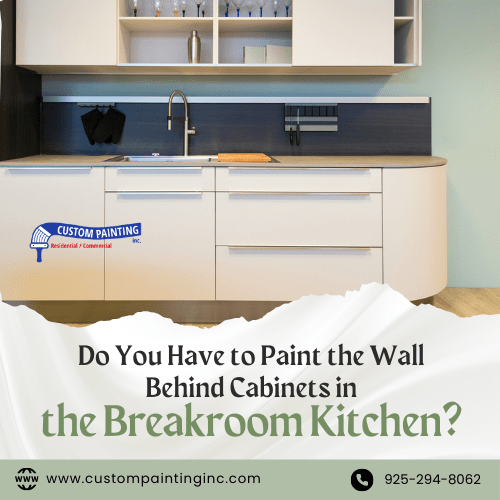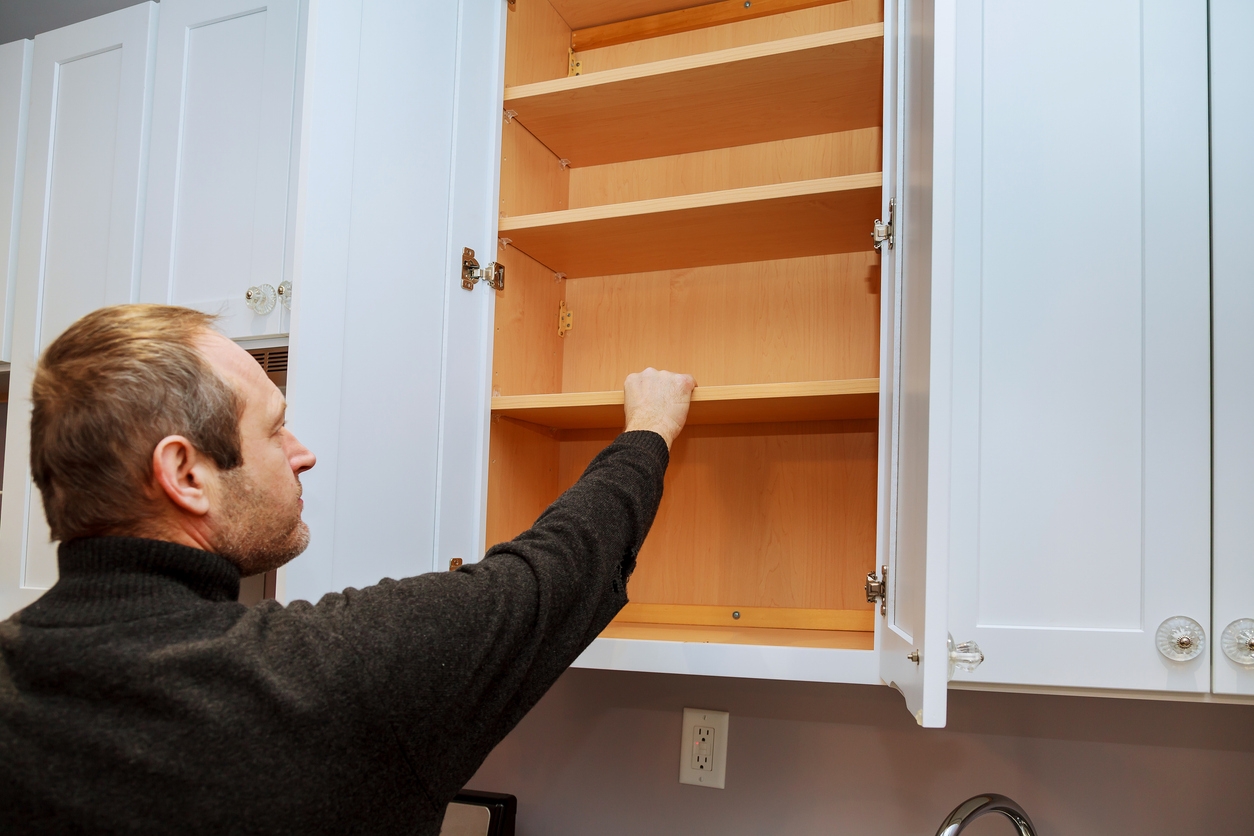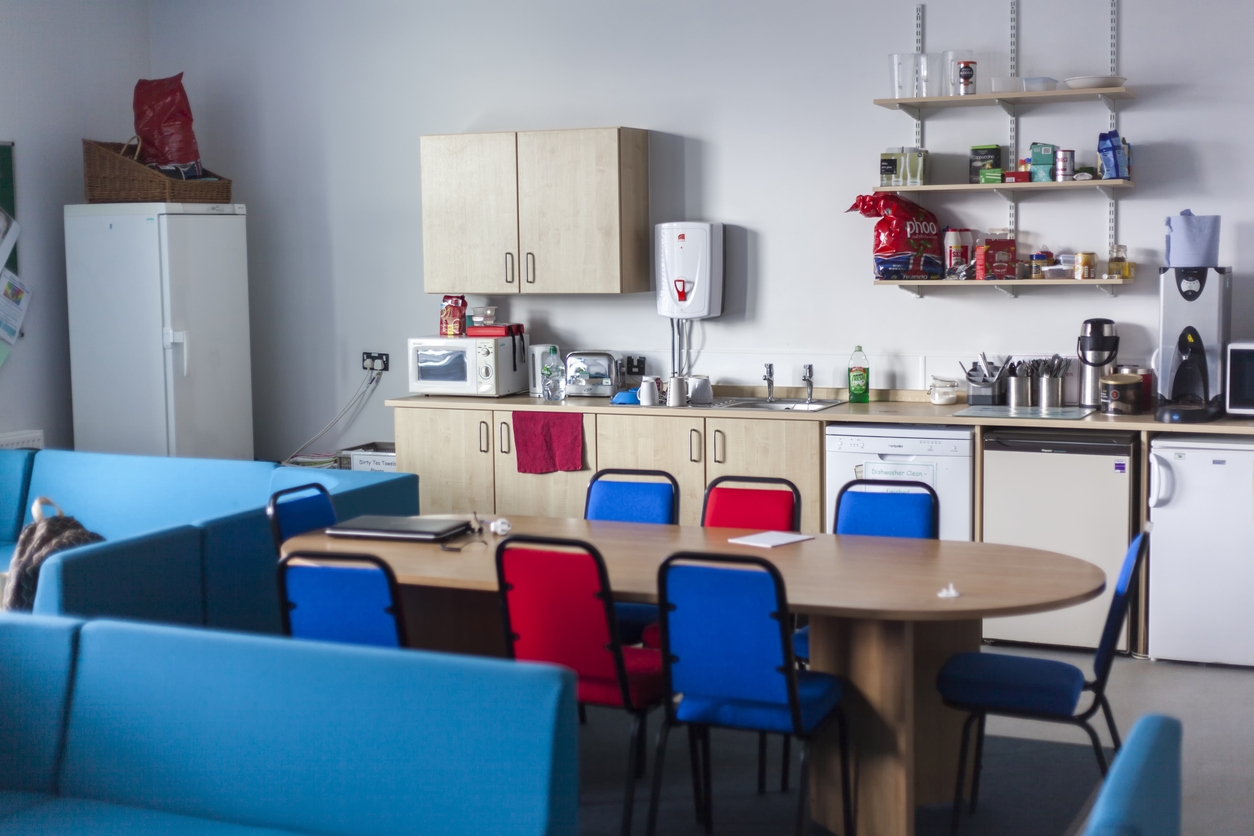Renovating a commercial breakroom kitchen involves numerous decisions, and one often overlooked is whether to paint the wall behind the cabinets. This detail might seem minor, but it can impact the overall look and maintenance of the space. In this article, we’ll discuss the considerations for painting the wall behind breakroom kitchen cabinets, helping you make an informed choice for your commercial space.
Understanding the Purpose
When renovating or setting up a commercial breakroom kitchen, deciding whether to paint the wall behind the cabinets is a choice that can affect both the aesthetic and practical aspects of the space. Here’s why you might consider this step:
Aesthetic Reasons
- Seamless Look: Painting behind the cabinets can create a seamless and uniform appearance. Even though the area is largely hidden, gaps or spaces between the cabinets can expose the wall, making an unfinished surface noticeable.
- Future Flexibility: If you ever decide to rearrange or replace the cabinets, having a painted wall ensures that the space looks complete and doesn’t require additional touch-ups or painting at that time.
- Quality Perception: A fully painted wall can give the impression of a thorough and well-executed renovation. This can enhance the perceived quality of the space, which is important in a commercial setting where image and professionalism matter.
Practical Reasons
- Moisture Protection: Kitchens are prone to spills and humidity. Painting the wall behind the cabinets can add an extra layer of protection against moisture, reducing the risk of mold or mildew forming in hidden areas.
- Ease of Maintenance: Painted walls are easier to clean and maintain. In the event of a spill or if the cabinets are removed for maintenance, a painted surface is simpler to wipe down and keep clean.
- Longevity of Materials: Paint can act as a barrier that protects the underlying wall material from wear and tear. This can be particularly important in high-traffic commercial environments where durability is key.
Considering both aesthetic and practical reasons can help you decide whether painting behind the cabinets is worth the extra effort and cost. Ultimately, this choice can contribute to a more polished and long-lasting breakroom kitchen.
Pros of Painting Behind Cabinets
Here are some of the advantages that you can get when you paint behind cabinets:
1. Enhanced Aesthetics
- Uniform Appearance: Painting the wall behind the cabinets ensures a consistent color scheme throughout the kitchen, which is particularly noticeable in any gaps between cabinets or around the edges. This creates a seamless, professional look.
- Future Renovations: If you plan to remodel or rearrange the cabinets in the future, having a painted wall ensures that the space remains aesthetically pleasing without the need for additional painting.
2. Improved Durability and Maintenance
- Moisture Protection: Paint can provide a protective barrier against moisture, which is crucial in a kitchen environment prone to spills and humidity. This helps prevent mold and mildew from developing in hidden areas behind the cabinets.
- Easy Cleaning: A painted surface is easier to clean compared to bare drywall or other unfinished materials. This makes maintenance simpler, especially in a commercial setting where cleanliness is a priority.
3. Increased Value and Perception
- Professional Quality: A fully painted wall reflects attention to detail and a commitment to quality, enhancing the overall perception of the space. This can be particularly important in a commercial setting where image matters.
- Potential for Repurposing: If the space behind the cabinets ever becomes exposed due to changes in layout or renovations, having it painted ensures that the area looks finished and professional without requiring additional work.
4. Flexibility in Design
- Design Continuity: Painting behind the cabinets allows for flexibility in future design changes. If you decide to install open shelving or reconfigure the cabinetry, the painted wall will already match the rest of the room, facilitating an easier transition.
- Color Coordination: Ensuring the wall is painted allows for better color coordination with the cabinets and other elements in the kitchen, contributing to a cohesive design.
5. Protection for Wall Materials
- Extended Lifespan: Paint can protect the underlying wall material from damage, wear, and tear. This is especially important in commercial kitchens where the environment can be more demanding.
- Barrier Against Dust and Debris: A painted surface can reduce the accumulation of dust and debris behind the cabinets, making the space cleaner and healthier.
By considering these benefits, you can determine that painting behind the cabinets is not just about aesthetics but also about maintaining a durable, clean, and professional-looking breakroom kitchen.
Cons of Painting Behind Cabinets
While there are many advantages, here are some of the few disadvantages of painting behind cabinets:
1. Increased Time and Cost
- Additional Labor: Painting the wall behind the cabinets requires extra labor, which can increase the overall time needed to complete the renovation. This can be particularly challenging in a commercial setting where minimizing downtime is crucial.
- Higher Expenses: The cost of paint and labor for a largely hidden area might seem unnecessary, especially when budgets are tight. Allocating resources to paint behind cabinets could divert funds from other important aspects of the renovation.
2. Limited Visibility
- Hidden Work: Since the painted area will be concealed by cabinets, the effort put into painting might go unnoticed. This can feel like a waste of time and resources, particularly if the primary goal is to enhance visible areas of the kitchen.
- Questionable Necessity: For many, the fact that the wall behind the cabinets is out of sight makes painting it seem unnecessary. This is especially true if there are no plans to change the cabinet layout in the foreseeable future.
3. Potential for Future Changes
- Risk of Covering Up: If the cabinets are securely installed and unlikely to be moved, painting the wall behind them may be redundant. Future changes to the kitchen layout may render the painted area irrelevant if new cabinets or structures cover it up again.
- Maintenance Redundancy: In a busy commercial kitchen, the area behind cabinets is not easily accessible for cleaning or maintenance. Painting it may not significantly contribute to the overall upkeep of the space, as it remains hidden and difficult to reach.
4. Practical Challenges
- Difficult Access: Painting behind cabinets can be physically challenging, requiring painters to work in tight, confined spaces. This can make achieving a high-quality paint job in those areas more difficult.
- Inconsistent Finish: Achieving a uniform paint finish behind cabinets can be tricky due to limited access and visibility. If the painted area is ever exposed, this could potentially lead to a less professional appearance.
5. Alternatives Available
- Back Panels: Instead of painting, using back panels or unfinished surfaces can be a more practical and cost-effective solution. These can be easily installed and provide a clean look without the need for paint.
- Cabinet Design: Modern cabinet designs often include back panels that cover the wall entirely, making painting unnecessary. Choosing such cabinets can save time and resources.
By weighing these cons, you can decide whether painting the wall behind the cabinets is the best use of time and resources for your commercial breakroom kitchen renovation. In many cases, focusing on more visible and accessible areas may provide better returns on your investment.
Alternative Solutions
When considering the necessity of painting the wall behind breakroom kitchen cabinets, it’s important to explore alternative solutions that can save time and money while still providing functional and aesthetic benefits. Here are some effective alternatives:
Using Wallpaper or Contact Paper
Wallpaper and contact paper offer a versatile and cost-effective way to cover the wall behind cabinets:
- Ease of Application: Both wallpaper and contact paper are relatively easy to apply, requiring less time and effort compared to painting. They can be cut to fit the exact dimensions of the wall behind the cabinets.
- Design Flexibility: With a wide range of patterns, colors, and textures available, wallpaper and contact paper allow for creative design choices. This can add a unique touch to your breakroom kitchen without the permanence of paint.
- Removability: If you decide to change the layout or style of the kitchen in the future, wallpaper, and contact paper are easy to remove and replace, making them a flexible option for evolving design preferences.
Sealing the Wall with a Clear Protective Coat
Applying a clear protective coat to the wall behind cabinets can offer practical benefits without altering the appearance:
- Moisture Protection: A clear sealant can protect the wall from moisture and spills, which is essential in a kitchen environment. This helps prevent mold and mildew from forming in hard-to-reach areas.
- Preserving the Original Wall: A clear coat maintains the wall’s original look while adding a layer of protection. This can be particularly useful if the wall is already in good condition and you want to keep its natural appearance.
- Easy Maintenance: Sealed walls are easier to clean and maintain. Any spills or splatters can be wiped off without damaging the underlying surface.
Leaving It Unpainted if the Cabinets Are Permanent
In some cases, it might be practical to leave the wall behind the cabinets unpainted, especially if the cabinets are intended to be a permanent fixture:
- Cost Savings: Leaving the wall unpainted eliminates the need for additional materials and labor, reducing the overall renovation cost. This can be particularly beneficial in budget-conscious projects.
- Time Efficiency: Skipping the painting process saves time, allowing the renovation to be completed more quickly. This is crucial in commercial settings where minimizing downtime is important.
- Hidden Nature: If the cabinets are designed to be permanent and completely cover the wall, painting may be unnecessary. The wall will remain hidden, making the effort and expense of painting it redundant.
Additional Tips
To ensure the best outcome for your breakroom kitchen renovation, consider these additional tips when deciding whether or not to paint the wall behind the cabinets:
1. Evaluate Cabinet Design and Installation
- Check for Gaps: Before making a decision, examine the cabinet design and installation. Look for any gaps or spaces where the wall might be visible. If there are significant gaps, painting or covering the wall might be more necessary.
- Permanent vs. Temporary: Determine if the cabinets are meant to be a permanent fixture or if there’s a possibility they might be moved or replaced in the future. Permanent cabinets might not require the wall behind them to be painted.
2. Use Quality Materials
- High-Quality Paint: If you choose to paint, use high-quality paint that can withstand the kitchen environment, including moisture and heat. This ensures durability and longevity.
- Durable Alternatives: For alternatives like wallpaper, contact paper, or sealants, choose products specifically designed for kitchen use. This ensures they can handle the conditions and last longer.
3. Professional Consultation
- Expert Advice: Consult with a professional contractor or interior designer. They can provide valuable insights and recommendations based on their experience, helping you make the best decision for your specific situation.
- Budget Planning: Work with professionals to plan your budget effectively, ensuring you allocate funds where they’re most needed without overspending on unnecessary areas.
4. Plan for Future Changes
- Flexibility: When making your decision, consider future changes or renovations. Opt for solutions that offer flexibility, making it easier to adapt to new designs or layouts without extensive rework.
- Storage Solutions: Consider integrating storage solutions, such as open shelving, that might expose the wall behind the cabinets. Planning for these possibilities can influence whether or not painting the wall is necessary.
5. Maintenance Considerations
- Ease of Cleaning: Choose finishes and materials that are easy to clean and maintain. This is particularly important in a commercial kitchen where cleanliness is paramount.
- Regular Inspections: Periodically inspect the area behind the cabinets for signs of moisture damage or mold. This helps ensure that whatever solution you choose continues to protect the wall effectively.
Conclusion
Deciding whether to paint the wall behind the cabinets in your breakroom kitchen involves weighing the aesthetic and practical benefits against the potential drawbacks and costs. While painting can provide a seamless look and added protection, alternative solutions like wallpaper, contact paper, or clear sealants can offer similar benefits with less effort and expense. Ultimately, the choice depends on your specific needs, budget, and future plans for the space.
For expert advice and professional assistance with your breakroom kitchen renovation, contact Custom Painting, Inc. by calling 925-686-0903 or by filling out our contact form. Our experienced team can help you make the best decision for your commercial space.




